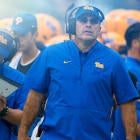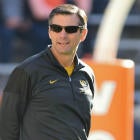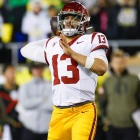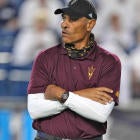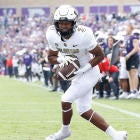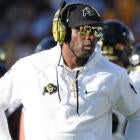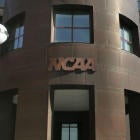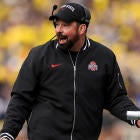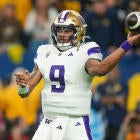While football may be a university's way of introducing itself to the world, its primary purpose is to be an institution of higher learning. That's why the schools and NCAA are so adamant about calling their players student-athletes. If you bring up that those student-athletes should be earning a larger share of the millions upon millions of dollars they help generate for the school, you're reminded that they are paid. With scholarships. Scholarships that help them earn degrees from an institution of higher learning.
Well, maybe it's time the schools started affording the same opportunity to their football coaches. Another weekend has come and gone where I'm left scratching my head at some of the decisions the coaches charged with leading these student-athletes made. We'll start with one of the most noticeable decisions over the weekend.
Pitt found itself trailing rival Penn State 17-10 with a little over eight minutes to play in the game. The Panthers had the ball at their 34-yard line and began a drive that would determine the game. After only a few plays, it seemed like it was already over. Pitt faced a fourth-and-1 at its 43, but instead of punting, Pitt coach Pat Narduzzi made the correct decision to go for it. Some would call it risky, and while there's risk involved in the decision, there's risk involved in nearly every decision made by a football coach. Years of data shows us that going for it in that situation increases your team's chances of winning more often than not. The decision would pay off, as Kenny Pickett hit Nakia Griffin-Stewart up the seam for a 36-yard gain. It was a huge moment that made what Narduzzi would do a few minutes later all the more baffling.
With 5:50 left in the game, still trailing by a touchdown, the Panthers had a first-and-goal at the 1-yard line. They would run three plays and fail to score, leaving them in a fourth-and-goal situation from that same 1-yard line. That's when, just a few minutes after knowing he had to go for it on fourth down from his own 43, Narduzzi decided he needed a field goal. A field goal that would still leave his team in a position where it needed a touchdown. Alex Kessman's 19-yard field goal attempt was no good, and it made the decision look worse, but it was never a good decision. Narduzzi's explanation after the game -- which Pitt would lose 17-10 -- was even more puzzling, as he said he decided to kick the field goal "because you need two scores" to win the game.
"The field goal was a good play, and then you come back and score again," Narduzzi said. "You can go back and question the fourth-and-1, go for it, or not go for it. Go for it, and you don't get it, it's like, why didn't you kick the field goal? You needed two scores to win the football game, and that's what it comes down to. You need two scores."
First of all, when down seven, you only need one score to win the game. The two-point conversion exists, and it has for quite some time. Second of all, while some people might have asked why you didn't kick the field goal had you gone for it and failed, fear of having to answer questions is not a good excuse for hurting your team's chances to win the game. Would Pitt's chances have increased had it made the field goal? Of course, but not by as much as you might think. And they certainly would have increased a lot more had Pitt gone for it and scored a touchdown. The key is you should make the decisions that give your team the best chance of winning, and that's not what Narduzzi did.
And Narduzzi was not alone on Saturday. This happened all over the country, and it happens every weekend on both the college and NFL levels. While Pitt and Penn State were doing battle, Will Muschamp was making several aggressive decisions at South Carolina against Alabama. They didn't all work out, but they were the kinds of things a team needs to do if it's going to topple a team like Alabama. There aren't many teams who can line up across the line of scrimmage against Alabama and just beat it playing a straightforward approach. And that's why a decision Muschamp made early in the fourth quarter was baffling. The Gamecocks trailed Alabama 34-13 to start the final frame when they faced a fourth-and-10 at the Alabama 30. Instead of going for it, South Carolina settled for a field goal. Now, it's not easy to convert a fourth-and-10 against Alabama, but when you're down three scores in the fourth quarter, you don't have much of a choice. Muschamp thought he did, however, and he kicked the field goal. It was good. South Carolina had cut a three-score deficit to a ... three-score deficit.
According to ESPN's win expectancy metric, the Tide had a 99.3 percent chance of winning the game before the field goal. It increased to 99.8 percent following the field goal. By kicking it, and making it, South Carolina effectively eliminated what little chance it had left of winning the game.
In Syracuse, Dino Babers' team trailed 14-0 against Clemson early in the second quarter. With a fourth-and-3 at the Clemson 11, Babers opted for the field goal to turn a two-score deficit into a two-score deficit. Now, this was much earlier in the game than when Muschamp took the three points, but the math wasn't all that different when considering the context of who Syracuse was facing. ESPN's win expectancy gave Clemson a 97.1 percent chance of winning the game at that point. Following the field goal, it increased to 97.8 percent. Later in the second quarter, now trailing 17-3, Syracuse faced another fourth down. This time it was a fourth-and-goal from the Clemson 5. Again, Syracuse decided to cut a two-score deficit to a two-score deficit. The field goal was good. It cut Clemson's win expectancy from 96.9 percent to 96.2 percent.
We need to do a better job of educating coaches about the decisions they make. I'm not arguing that all decisions a coach makes should be based on math -- that's not realistic. There are always other factors at play in a football game. Many of them are known to the coaches, and not those in the stands, press box or at home watching on television. But that can't be the case as often as we see decisions this poor being made. If a coach's job during a game is to do everything in their power to maximize their team's chances of winning the game, then they need to be better informed of the decisions they are making. And, if they are being given this information, they need to do a better job of accepting it.
I've used examples from three different coaches in three different games on Saturday, but believe me, they weren't the only ones making these decisions. It happens everywhere, and it happens with coaches who have won a lot of big games, and have rings on their fingers. Everybody can afford to be better at their job.
Maybe instead of paying their coaches millions of dollars, some of these schools should reward them with scholarships so they can take a class or two that could help them on Saturday.
Kansas of the Week
This week's Kansas of the Week Award goes to Kansas, which went on the road and beat Boston College 48-24 on Friday night. Now, this was a remarkable accomplishment for a few reasons, not the least of which was that Kansas went on the road and won a football game. Last season, the Jayhawks went on the road and beat Central Michigan 31-7. That in and of itself might not seem like a big deal, but it was the first time Kansas had won a football game on the road since beating UTEP 34-7 in 2009. Yes, it had been nearly a decade between road wins.
Friday night's win over Boston College was the first time the Jayhawks had gone on the road to beat a Power Five team since beating Iowa State 35-33 on Oct. 4, 2008. It had been more than a decade, and Kansas not only won this game, they dominated it. And it did all of this a week after losing at home to Coastal Carolina. All of which means that we're only three weeks in, and Kansas fans already have a total grasp of The Les Miles Experience. It might be hectic, but it's a lot more fun than anything else the Jayhawks have experienced lately!
I get it. pic.twitter.com/0j0CNCxuhL
— Barrett Sallee (@BarrettSallee) September 14, 2019
Reminder That Alabama Isn't Fair of the Week
NAJEE HARRIS, YOU CAN'T BE SERIOUS!
— CBS Sports (@CBSSports) September 14, 2019
• Run someone over
• Hurdle someone
• Drag someone into the end zone pic.twitter.com/pFnPok0HU3
I mean, come on! I made a comment while watching Alabama on Saturday that every Alabama touchdown seems so easy, and this does nothing to change it. Yes, Najee Harris had to throw one poor defender into oblivion, hurdle another, and break an arm-tackle attempt, but how did he make something so badass look so easy? Like, at what point of that play did you not think he was going to score? Alabama isn't fair.
Photo of the Week
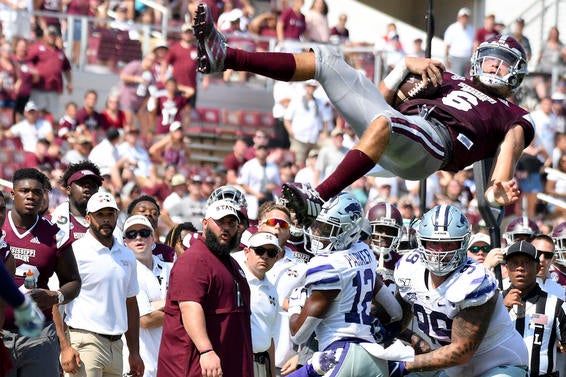
That daring soul helicoptering through the air is Mississippi State quarterback Garrett Shrader. Garrett is not Mississippi State's starting QB, but as is so often the case in this sport, he found himself thrust into duty after Tommy Stevens was benched following a second interception. Shrader's first drive went well as he led the Bulldogs to a touchdown and a 21-17 lead. Things didn't go nearly as well after that, but it wasn't for a lack of effort.
We see Garrett in mid-air here as he was attempting to help his team tie the game. The Bulldogs trailed 31-24 with under three minutes to play and faced a fourth-and-16. With nothing open down the field, Shrader did the only thing he thought he could do. He put his body on the line to try to get the first down.
And he came up short.
Matrix pic.twitter.com/pWN0utNwjk
— Big Cat (@BarstoolBigCat) September 14, 2019
Mississippi State would go on to lose by the same score, but Shrader's still a hero. That was the kind of play you see in every football movie but rarely see in a football game. Of course, the other key difference is that, in the movie, the player scores, wins the game, and lives happily ever after. All Shrader's left with is a sore tailbone.
Tom Fornelli Team of the Year Dropouts of the Week
Beginning in 2019, The Tom Fornelli Team of the Year Award, presented by The Tom Fornelli Foundation For Football Exceptionalism, is to be given out to one incredible football team that best displays the values of The Tom Fornelli Foundation For Football Exceptionalism. Every week, teams will be eliminated from the running for reasons. Those reasons are at the sole discretion of Tom Fornelli and The Tom Fornelli Foundation For Football Exceptionalism, which is comprised of Tom Fornelli and nobody else. Here are the teams eliminated from consideration in Week 3.
School | Reason for Elimination |
Arkansas State | You get shutout, you're gone |
Boston College | You lost to Kansas by 24 points at home in football |
Illinois | I'm just mad at them, all right? |
Pitt | Your coach said you need two scores to take the lead when down 7 and that doesn't inspire a lot of confidence. |
Stanford | Let down UCF detractors everywhere by getting your butt kicked in Orlando |
South Carolina | Kicked a FG down 21 points to Alabama in the 4th quarter to cut a 3-score lead to a 3-score lead |
Teams Eliminated Last Week: Arkansas, Bowling Green, Central Michigan, Cincinnati, Rutgers, Syracuse, Washington, West Virginia
To see a complete list of eliminated teams and reasons why, go here.
AP Voters of the Week
Usually, this spot is reserved for an AP voter whose ballot I vehemently disagree with, but this week I'm choosing to spotlight two voters who did a better job than most of their colleagues. Both James Kratch of The Star-Ledger and Ryan Aber of The Oklahoman had UCF at No. 10 on their ballot this week. UCF destroyed Stanford 45-27 on Saturday, and the Knights were rewarded for it by moving up a whole two spots in the AP Top 25 poll! The Knights are at No. 15 now.
For years, fans and media have said that UCF needs to play Power Five programs to prove itself. On Saturday, the Knights played a Stanford team that, admittedly, isn't as good as it has been in recent years, but has shown to be one of the more powerful programs of the last decade. This is a Stanford program that has won three Pac-12 titles and been to three Rose Bowls since 2012. In other words, it's the type of team people have been claiming UCF needs to play the last few years. So I get a bit annoyed when UCF does play that team, smokes it, and most voters refuse to reward the Knights for it.
I point out Kratch and Aber here because they were the two voters who had UCF the highest on their ballots, though 19 others at least had them in the top 14. The other 36 voters had UCF ranked 15th or lower, with the Charleston Gazette-Mail's Tom Bragg having them as low as 21.
Now, let's play a game. Let's pretend a Power Five program like Oregon State, without a long history of football success, entered the 2019 season having gone 25-1 with a Peach Bowl win over Auburn, and the lone loss being a Fiesta Bowl loss to LSU. Oregon State then improved to 3-0 in 2019 on Saturday by beating Stanford 45-27 after holding a 38-7 lead on the Cardinal at halftime.
Where would Oregon State be ranked right now? I'd bet it would be in the top 10 instead of having only two voters putting it at No. 10. Hell, I know it would be in the top 10 because, in 2012, after starting the season 4-0, the Beavers were ranked in the top 10 of the AP Top 25. They began the year unranked after going 3-9 in 2011 and 5-7 in 2010. Yet, for some reason, Oregon State only needed four wins to prove it was a top 10 team.
UCF has gone 28-1 since the start of 2017 and can't even get higher than No. 15 on most ballots. At some point you have to accept the fact this team is just as good, if not better than most of the filler you're putting above it every week. Do better, AP voters.
Stat of the Week
Here is a chart that documents the number of Big Ten wins teams have since the beginning of the 2017 season.
Team | B1G Wins |
Ohio State | 17 |
Northwestern | 15 |
Wisconsin | 14 |
Michigan | 13 |
Penn State | 13 |
Michigan State | 12 |
Iowa | 10 |
Purdue | 9 |
Nebraska | 6 |
Maryland | 5 |
Minnesota | 5 |
Indiana | 4 |
Eastern Michigan | 3 |
Rutgers | 3 |
Illinois | 2 |
Eastern Michigan, which has as many wins as Rutgers, and more than Illinois, is not a Big Ten team. It beat Rutgers in 2017, Purdue in 2018, and Illinois on Saturday.
College Football Playoff Projection of the Week
1. Clemson
2. Alabama
3. Ohio State
4. Oklahoma
Until the next Monday After!












